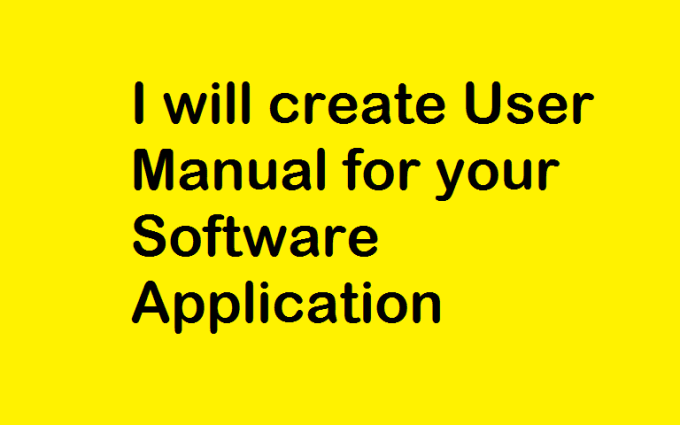How To Create User Manual For Application
Nov 21, 2017 It really depends on your audience, purpose, and content/length. If you are writing short memos, reference guides, or release notes for developers and engineers, then MS Word will do just fine, especially if it’s a 10 or 20 page document. The user manual should be largely task-oriented, rather than heavily descriptive. Because the manual is written to help users understand how to execute specific tasks, the writer needs to have an understanding of those tasks as well, and as a result, going through each. Ever wonder how to create an app? Learn how to make and build a mobile app in 12 easy steps. Build mobile apps for Android or the iPhone with this tutorial. Create without code - use our Digital Adoption Platform to create interactive walkthroughs, tooltips and support articles right in your app. Launch Inline Manual Experience See how it helps. Trusted by 500+ Enterprises, SaaS businesses and SMBs all around the world. User onboarding.
Create A How To Manual
How to create a workspace. Workspaces can be created for different purposes and for different audiences (different permissions). A prerequisites for creating workspaces is that you have been assigned the role 'Workspace Creator' in Azure Active Directory.Follow these instructions when creating a.

In your day-to-day work, you might find that there are times when you need to provide a client with documentation that walks them through a process or teaches them how to do something they may be unfamiliar with.
I’ve mentioned before that I view writing skills as vitally important for everyone, in every business, and this is a prime example of why being able to write effectively is so important. If you can’t get the steps and details down on paper in an easy to understand and intuitive way, you will probably spend a great amount of time and frustration handling support requests and fixing things done incorrectly.
Here are seven tips to help you create a comprehensive yet coherent instruction manual.
Brivis networker nc-1 user manual. The Brivis 'Networker' terminals are normally labelled 'TW1' and 'TW2'.At the heater unit, the terminals are labelled with TW1 and TW2. Here is what I worked out. (If you zoom in near the brown cable, you will just make out the labels).Unfortunately, the cable used by the installer doesn't have any 'trace' - not even a ridge in one side. The two terminals on the back of the 'networker' controller itself don't seem to have any markings either.Does anyone know if the wiring of this type of controller is polarized, or can it be wired any way around?Thanks in advance for any replies.(I wish I could remember where I put the installation manual ).
- Get out of your own head: When you begin to prepare instructions for processes you know inside and out, you will need to consciously take a step back and approach the material from a new angle. Start at square one by assuming the audience will have zero knowledge of the subject matter.
- Know the objective: Make sure you know exactly what your manual needs to cover in order to avoid information overload or confusion that can come from too many details. This is especially important when the process is complex or has a lot of different parts.
- Outline it first: Before jumping in and creating steps, create a high-level outline of what the document will cover, including main and subsections. This will help you make sure your process makes sense and that each section of the manual is consistently structured.
- Make it easy to understand: Lists are a great way to outline steps for doing something because they can help people move item by item in the way you intend. It’s also a good idea to use a table of contents and make your document searchable, if possible, to further support your step-by-step approach.
- Be brief: It’s tempting to want to explain everything in fine detail since it’s material you know so well, but stick with only what the recipient needs to know. Focus on using only as many words as necessary to get your point across.
- Use visual aids: Screenshots, diagrams and even videos are a great way to beef up your manual and make it easier to understand. Keep the formatting of these supporting materials consistent and to the point to avoid overwhelming the reader.
- Give it a test drive: Or better yet, have someone else who has never seen the material before run through the instructions. Take their feedback and use it to fine tune your manual.
Keep in mind that you may need to review and update the manual periodically, especially if it’s something that focuses on a third-party application or other system you do not control. Plus, with some material, it may also make sense to offer the client a hands-on walk through to ensure your instructions accomplish what they need to accomplish. And keep in mind that learning styles vary, so one client may be able to run with the same instructions that confuse a different client. Being flexible in your format and delivery can help make sure the instructions work for the recipient.
Do you ever provide clients with written instructions? What advice do you have?
Software To Create User Manual
Image credit: svilen001